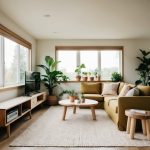Mastering the Art of Minimalist Home Decor: Tips for a Clean, Chic Space
Smart Storage Solutions
Smart storage solutions can transform a cluttered space into a sleek and organized sanctuary. Investing in multi-functional furniture and adopting key organizational practices will keep your home stylish yet tidy.
Maximizing Space with Multi-Functional Furniture
Multi-functional furniture can save valuable space without sacrificing style. A bed with built-in drawers can eliminate the need for a separate dresser. Sofa beds or futons offer seating by day and a sleeping area by night, perfect for small apartments or guest rooms.
An ottoman with internal storage provides a place to put your feet up while hiding extra blankets or magazines. Shelving units that double as room dividers can create distinct areas in an open-plan space while providing storage. Choosing furniture that performs double duty maximizes efficiency and keeps the home looking organized.
Organizational Tips for Maintaining Simplicity
Maintaining simplicity in a minimalist home requires thoughtful organization. Start by assigning specific places for different items to ensure everything has a home. Labeling containers and bins can help keep things in order. Regularly declutter and remove items you no longer use or need.
Implement a “one in, one out” policy to avoid accumulating unnecessary things. Make use of vertical space by installing shelves and hooks. Baskets and boxes can corral small items, reducing visual clutter. Consistently applying these practical tips will keep your minimalist space clean and serene.
Lighting to Enhance Minimalism
Lighting plays a crucial role in minimalist home decor. The right balance of natural and artificial light can transform a space, making it feel more open, serene, and stylish. Thoughtfully chosen light fixtures can further enhance the mood and aesthetic.
Natural and Artificial Lighting
Natural light is fundamental to minimalist design. Large windows, skylights, and glass doors are effective ways to draw in natural light. Soft, diffused light creates an airy atmosphere, reducing the need for artificial lighting during the day.
Sheer curtains or blinds are recommended to control the light while maintaining privacy. For artificial lighting, consider using LED strips and recessed lighting. These provide consistent illumination without cluttering the space.
Dimmable lights add flexibility, allowing adjustments based on the time of day or activity in the room. Pendant lights with simple designs work well in dining areas or kitchens, blending functionality with minimalist aesthetic.
Creating Mood with Light Fixtures
Light fixtures can significantly influence the ambiance. Sleek and contemporary fixtures that blend into the decor are ideal. Chandeliers and pendant lights with clean lines can serve as focal points without overpowering the room.
Wall sconces with minimalist designs offer subtle lighting, enhancing coziness in living spaces or bedrooms. Floor lamps with slim profiles can be strategically placed to create reading nooks or highlight artwork.
Track lighting is efficient for illuminating specific areas, maintaining a neat and orderly appearance. Consider using fixtures made from materials like metal or glass, as they complement the minimalist style, ensuring the space remains uncluttered and visually appealing.



